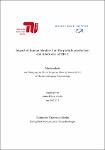Impact of human Staufen-1 on the particle production and infectivity of HIV-2
Amler, Anna-Klara
According to the World Health Organisation, there are 35 million people currently
infected with HIV worldwide. Untreated infection with the virus leads to a decline
of the CD4+ cell number and weakening of the immune system, resulting in the
development of AIDS (acquired immunodeficiency syndrome). This enables opportunistic
infections to arise, which may end in death of the infected person. HIV infections
are mostly caused by HIV-1, whereas distribution of HIV-2 is more restricted.
Due to the fact that viruses are not able to replicate themselves, they are reliant on
the host cell and interact with various cellular factors. The human RNA-binding
protein Staufen-1 has previously been reported to interact with various proteins of
the retroviruses HIV-1, HTLV-1 and HERV-K, affecting production and infectivity of
viral particles. Export of viral RNAs, translation of viral proteins as well as assembly
of new virions have been named as potential spots for mediating those effects.
Within this thesis, the aim was to investigate the eventual interaction of Staufen-1
and HIV-2, gaining more insights into the impact of Staufen-1 on the retroviral replication
cycle. It could be demonstrated that Staufen-1 enhances HIV-2 particle production
dose-dependently, while simultaneously impairing the infectious potential
of emerging virions. The dsRBD3 domain of Staufen-1 could be determined as the
potential domain mediating this effect. Furthermore, downregulation of the expression
of endogenous Staufen-1 resulted in impaired particle production. By creating
a reporter construct carrying the respective Rev-responsive element (RRE), the
Rev/RRE-dependent transport of unspliced RNAs could be investigated, on which
Staufen-1 had no influence. As the Rec protein was found to be a major Staufen-1 interacting
partner for HERV, the interplay of HIV-2 Rev and Staufen-1 was analyzed
more in detail. By means of fluorescence microscopy as well as the generated reporter
construct, the function of several HIV-2 Rev mutants was examined, a protein
involved in export of unspliced viral RNAs out of the nucleus. In this way, potential functional domains of HIV-2 Rev were investigated, which have not been defined
yet.
Taken together, an impact of Staufen-1 on HIV-2 could be demonstrated for the
first time, resulting in outcomes similar to the ones that have been reported for other
retroviruses. It remains to be elucidated at which stage of replication the interaction
takes place, whether other proteins are involved and by which means the impact of
Staufen-1 is important for the virus and the host cell.
Dateien zu dieser Publikation
Keine Lizenzangabe

